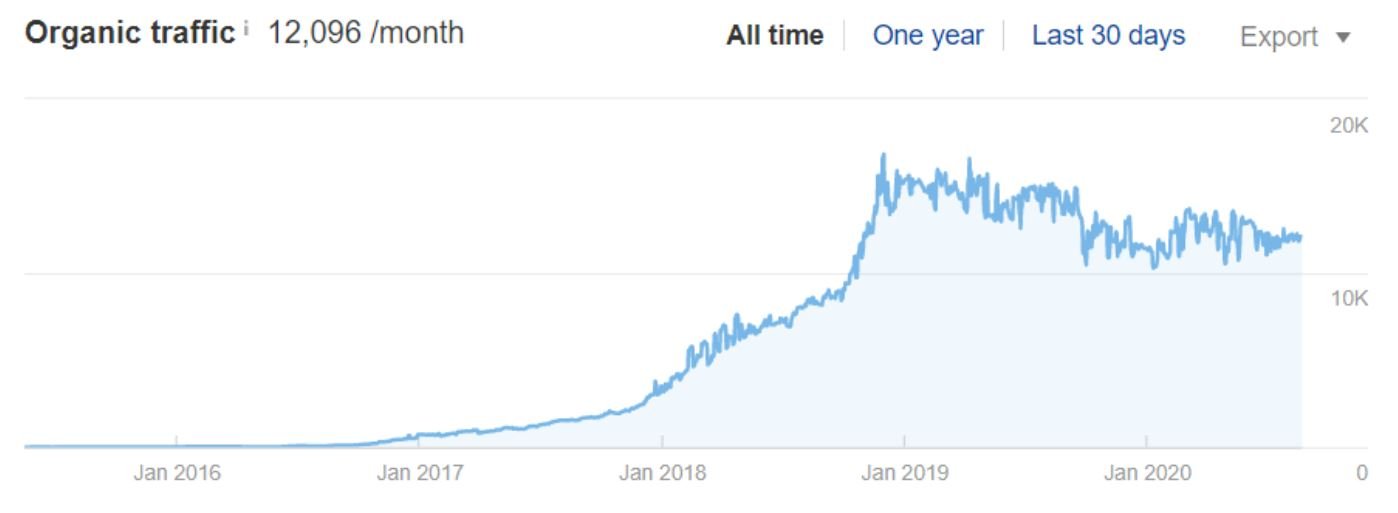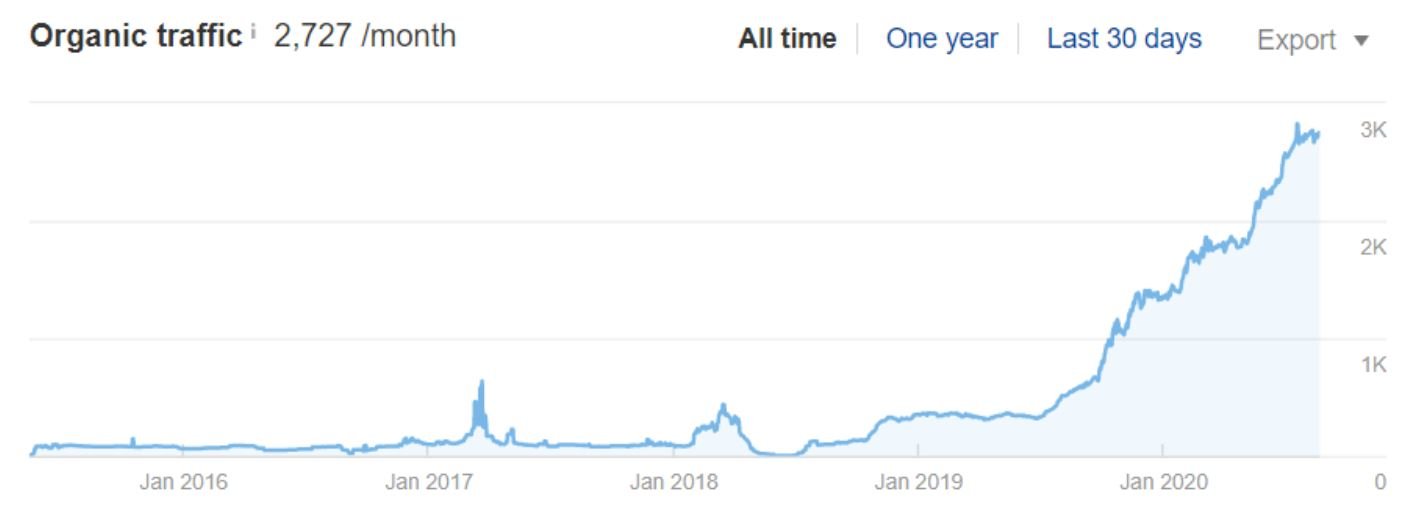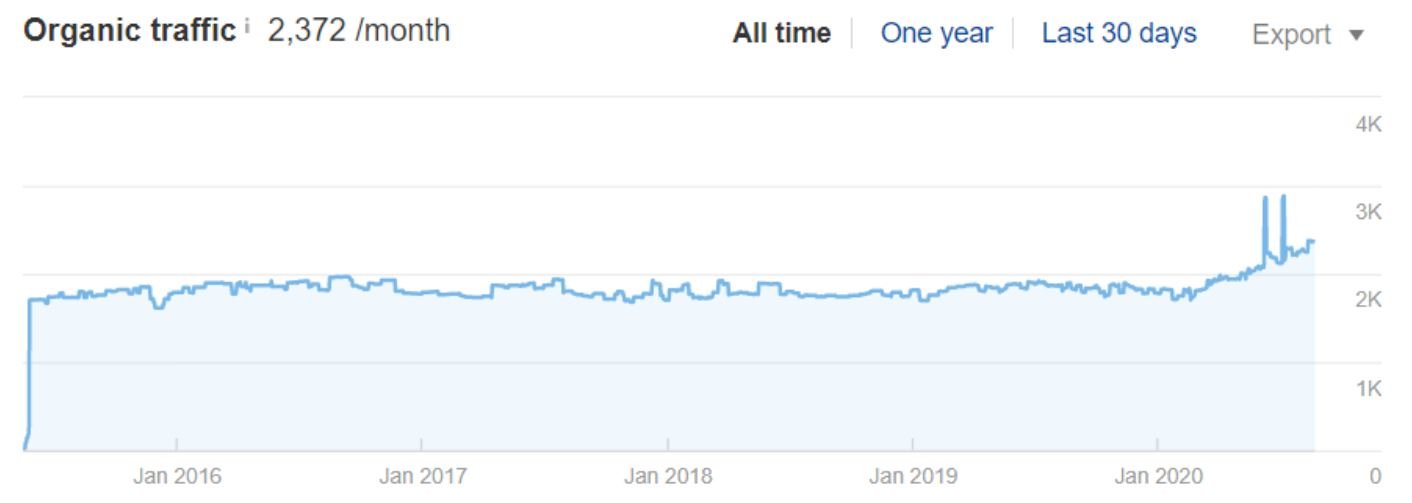
You’re probably rolling your eyes and thinking to yourself, “I don’t believe SEO works anymore.” The topic is overexposed and, at the same time, equally misunderstood. I mean, there is even an SEO Movie now…
Perhaps you are in disbelief that evergreen content performs better than newsworthy or viral content.
Or maybe you don’t buy into content marketing and its efficacy at all due to the overwhelming amount of content out there. While completely understandable, both of those ideas are simply not true…based on the data science behind posts that are 2,000+ words in length and are relevant today, tomorrow, and well into the future.
Moz, among others, has done study after study identifying the best performing content, SEO or otherwise, and hands down, evergreen content that is longer than 2,000 words gets more links, social shares, and longer dwell time than shorter content does.
It’s really that simple…
Later in this post, I am going to show you the stats of how I’ve grown organic Google traffic by 17,195 visits for three websites using a process I will explain in step-by-step detail. Stick with me. These are cold, hard facts.
However, creating engaging evergreen content seems complex and the process like a black box until you understand all of the proper steps that make up the process.
But I’m getting ahead of myself…
Allow me to unlock the secrets of my process on how to get long form content to rank in Google, starting with the basics. Feel free to skip right to sections that best fit where you are in your discovery of the process if you need to.
Disclaimer: This article does contain affiliate links. If you purchase a tool through one of my links, I will receive a small commission at no additional cost to you.
Which Section Do You Want to Read First?
What is Evergreen Content and How is It Different?

A lot of planning and research goes into nailing SEO, but extraordinary content is the foundation of great SEO. Furthermore, the type of content you’re creating plays an even bigger role. For the most part, there are two primary types of content:
- Topical, short-lived content: Content that is timely and relevant to a particular topic and generally shorter in length and depth. This type of content is generally news-related but can also play into a trend. Because of its timely nature, topical content can result in a short-term boost to your traffic, but it will generally fizzle out over time. This kind of content can be exhausting as you continually have to churn out new topical posts month after month to keep up with what’s trending.
- Evergreen content: This content focuses on offering timeless, invaluable, and in-depth information to the reader. Unlike topical content, evergreen content doesn’t focus as much on timely information, but information that will be relevant in 2, 5, 10, or 20 years from now. Evergreen content done well, and following a specific process, will result in much longer-term SEO traffic, as it contains information people will always be searching for and is more comprehensive in covering the topic. Plus, it will gain more social shares and backlinks over time, which just so happen to be the two primary ways to get Google’s attention.
In a nutshell, both of these content types provide a boost to your SEO. However, evergreen content provides a long-term sustainable arc (that typically continues to grow over time, not just stay flat), while topical content is in it for the short game. This doesn’t make topical or short form content bad, it simply serves a different purpose and shouldn’t be used as a primary way to drive SEO traffic.
Evergreen content does, however, require extensive research (both on keywords and the topic itself) and is usually much longer than topical content, around 2,000-5,000 words (sometimes as high as 30,000 or 50,000 words) to short form contents’ 500-1,500.
You might be thinking, “So Miles… I don’t believe that people will actually read a piece of content that is tens of thousands of words long.” And while people’s attention spans are indeed getting shorter, if you provide in-depth information on a topic that lots of people are searching, they will read it, link to it, and share it.
When you think of evergreen content, think of tip lists, guides, and so on. This piece from Imaginasium is a quality example of evergreen content on the (highly relevant) topic of inbound marketing strategy.
What is SEO Writing?

There’s no easy way to go about SEO. It’s a lot of hard work, and it takes time. That being said, short form or topical content can be a quick way to score some traffic to your site from places other than Google. So why not just continue doing short form content instead of the time consuming evergreen?
As the name implies, topical content is, well, topical. As long as a topic or subject is trending, topical content can thrive, netting you traffic. But when your topical subject has trended for the last time, so has your content. And this also assumes you have a large audience that already regularly visits your site.
So what if you don’t have a large following on social or don’t have much site traffic or don’t have a substantial email list?
That’s precisely where using evergreen content to garner SEO traffic from Google comes in…
Another thing to consider is that, because of how quickly short form content can be created, there’s a lot of competition. In a study done by Moz and BuzzSumo, they found 85% of one million articles examined were less than 1,000 words long. But in that same study, they found a positive correlation with the length of a piece of content and the number of shares it received on social media.

In a nutshell, short form content generally leads to smaller traffic gains and almost always draws traffic for a shorter period of time, if at all.
So it is time to decide: Are you in this for the long haul?
If the answer is no, evergreen content is not for you. That’s right, you heard me. If you don’t want to commit, evergreen content is not going to work.
Of course, I believe you should pursue this strategy (or else I wouldn’t be singing its praises), but only if you are going to stick with it for 18-36 months. It takes a while to write and publish quality content, and then you have to allow enough time for it to pick up initial traffic, gain links and social shares, and for Google to take notice.
I know you are eager to see results, but it simply takes at least that long to start seeing results…
Plus, this is one of those things that builds on itself over time. As you prove your authority on your topic to Google, it gets a little easier to rank the next article by linking from that high ranking post to your latest evergreen post. And on that note, let’s talk about authority.
What is Domain Authority & Page Authority? Why Both are Vital to SEO?

Before we get too far into how to create evergreen content, it’s important to understand domain authority and page authority and the huge role they play in SEO.
SEO gains will never be made if your domain or page authority is too low.
Domain authority (DA) is a useful system developed by multiple third party SEO tools (Moz & Ahrefs being two of them) used to gain insight as to why search engines favor certain websites over others. It measures a site’s potential SERP performance on a scale of 1 to 100 in comparison to other domains across the web. DA is determined using a series of factors, including (but not limited to) a site’s age, backlinks, popularity, trust, etc. If a site has a high DA, its content is more likely to rank higher than a site with similar content but a lower DA.
Similarly, page authority (PA or, as Ahrefs calls it, URL rating) is a scoring system that calculates how well a particular page may rank on SERP. Much like DA, this is determined by examining link counts, social shares, trust, and influence. A page with a high PA or URL rating is more likely to rank well for a particular keyword phrase than a similar page with a lower PA.
So why not just shoot for a DA and PA of 100 and call it a day?
First off, that’s much easier said than done. Most media sites struggle to stay above 90, and they are producing content every day. Plus, it is important to note that these metrics are a relative measure since this isn’t Google telling us their score for any given page. These are third party best guesses (based on data) and, while offering beneficial information about the standing of a site or page, are not infallible.
Basically, you want to know the DA and PA of your site and of your competitors’ to better inform the choices you make about your content. That way you don’t end up spending tons of time creating content that will never rank.
3 Benefits of Evergreen Content Marketing

So what are the benefits of content marketing? Why spend time creating content at all?
There are 3 simple, but profound benefits…
1. Become a Media Company: Getting More Eyeballs
Since top shared and linked content requires so many words, you might be wondering if there’s another way to go about strengthening your SEO (say, in 500 words or less).
Two words: there’s just not the same traffic potential.
In the current marketing landscape, creating quality content is everything. In fact, utilizing content marketing as a way to build brand awareness and essentially build your own media site for your brand is winning out over the effectiveness of digital ads themselves.
More and more people are tuning out ads (can you blame them?). With ad blockers and ad blindness proliferating, as well as digital ad costs expected to continue rising, it will get harder to compete for online advertising. So why not become your own media company where you own the ad channel (your blog traffic, email list, social media, etc.)?
The fastest way to build an audience is evergreen content getting organic traffic from Google.
So why not build the thought leadership for your business and just happen to sell them something at the same time? Think like a media company…
2. Lock in Lower Cost Advertising for Months & Years to Come
When viewed over the long term, the cost per conversion for content marketing is less compared to digital ads (61% less in fact). True, the upfront investment of evergreen content is more, but you benefit from that content continuing to rank on Google month-after-month, year-after-year.
Compare that with digital ads, which stop as soon as you stop paying for them.
But don’t let me get ahead of myself. For the uninitiated, content marketing is a type of marketing that involves the creation and sharing of content online. Think of it as a perfect marriage between content and promotion. Or in the words of Gary Vaynerchuk:
“If content is king, promotion is queen.”
3. Grow Traffic from Many Traffic Sources (SEO & Others)
Content marketing has blown up, and with good reason: it garners attention, strengthens your brand, and just about anyone can do it (although not everyone does it well or successfully). Most importantly, content marketing can do wonders for your SEO traffic. To get a clearer understanding of how content marketing works for SEO, let’s look at an example:
- Let’s say you have a business that sells hiking boots. While your site looks nice, it’s not getting any traffic. So, you turn to Google and see what people are searching for when it comes to them. Turns out, there are a few guides on choosing the best boots, but you know you can create one that is 10X better, curating all of their content and adding your own into one large master post.
- You perform extensive keyword research on all things pertaining to leather and boots using a reputable tool like SEMRush. Then, you create a killer guide on how to select the right hiking boots for you, taking care to incorporate key sections from similar posts that are already ranking. You load it with quality keywords (not keyword stuffing), some links to respected sites (again that are ranking themselves), evergreen videos, and use proper formatting.
- As readers begin to find your guide, they begin sharing it with their friends, who then share it with their friends, and so on. On top of that, people are starting to link to your guide in their own content. This is driving even more traffic to your site and building your page authority.
Obviously, the above example is grossly oversimplified, but it does show the basic benefits of content marketing: traffic, authority, rank….all things great for SEO.
"SEO makes demands. Content marketing fulfills those demands."
Neil Patel
The days of simply and inexpensively buying ad space on Google are over. As the market has matured, ad platforms are getting much more expensive and becoming less effective. This goes for Google ads as well as other digital ad platforms. While ad space can always help, many internet users demand more from their online experience. People want answers, and it’s your brand’s job to deliver in-depth value for free via content marketing long before they ever decide to purchase from you.
Quantifiable Results: Growth of 17,195 Quality Organic Google Search Visits

So where’s my proof? And how successful have I been at employing these strategies?
Well, I’m glad you asked. I’ve used these strategies on a number of websites, and here are results from 3 client websites (screenshots below) where I’ve employed evergreen content to generate consistently growing website traffic and lead generation growth.
Plus, here’s a quote from a satisfied client of mine:
“Like many businesses we wasted a lot of time and money on so-called experts who promised to get us online business through their latest gimmicks.
Then we engaged Miles. He and his team are legit content marketing experts, growing our organic Google search traffic from zero to over 2,400 visits a month using evergreen, long-form content. He truly knows how to get sustainable Google traffic the right way, producing high quality content based on topics potential customers are already searching for.
If you want to grow organic search traffic from Google, you would be wise to follow Miles’ prescription explicitly.”
–Fred Terlaak, Partner, ServiceBasix Garage Doors
Client Site #1

Client Site #2

Client Site #3

5 Critical Phases for Killer Content Marketing Strategy

Creating evergreen content isn’t as simple as putting a ton of words, images, or videos together and moving to the next item on your to-do list. There are some best practices that you would be wise not to ignore.
Each one of the following steps must be followed for the most success. Even proper completion of phase one and two will result in failure to gain organic traffic from Google if you don’t complete phase three, four, and five.
1. Why Keyword Research is an Absolute Must

Before you start working on any piece of evergreen content, proper keyword research is critical. While Google Keyword planner can help you get an idea of what’s out there, there’s no substitute for a paid tool like SEMRush or Ahrefs. This is because Google Keyword Planner focuses on paid search volume and competition (think Google Ads), which can be very misleading for organic search (SEO). But if you are just starting out, take a look at these free keyword research tools.
Relying on Google Keyword Planner alone can cause you to target a keyword for which you will never rank or that has much less search volume than you think.
Paid tools like SEMRush will not only help you research keywords you’re interested in but also show you what topics your competitors are covering and precisely how well they are ranking for them. This is crucial to your evergreen content, as it will help you fill in their knowledge gaps, giving your content a competitive edge.
When researching keywords, you want to identify one primary keyword and several related secondary keywords. Shoot for a primary keyword with a search volume of 500-1,500, unless your domain authority is already high, and make sure there’s not too much competition. Even if a word falls in that search volume range, high competition can make ranking for that word incredibly difficult. When considering secondary keywords, don’t limit yourself to the minimum of 500 in search volume, as lower volume words and phrases can still be beneficial.
2. Outlining, Curating (Not Plagiarizing), & Writing a “Best of the Web” Article

The next thing you’ll want to do is take a look at the articles that are ranking on page one for the primary keyword phrase you’ve selected. When creating your own evergreen content, choose 3 to 5 H2 elements as headings/subtopics that are common to the competitor pages ranking on page one of Google for that primary keyword for your outline.
We do not condone plagiarism in any form, but curating the best of your competitors’ pages is the best way to create an article that is better than all the others.
To avoid any danger of this, always run your content through an online plagiarism checker to ensure that you have unique information.
Once you have your high level outline, you start writing the body beginning with your H1, then filling in those 3 to 5 H2s, perhaps adding H3s when it is warranted. Pace yourself based on that outline so that you don’t end up with too little or too many words.
Once you have the bulk of the writing complete, identify videos that pertain to the keyword phrase and are also ranking on the first page of either a Google or YouTube search. Sprinkle these throughout the post and add images throughout the article, as well, to make it visually interesting. After all, these posts are 2,000+ words, and you need elements to keep readers engaged other than just words.
3. 7 Keys to Structuring On-Page SEO Correctly
When doing the actual writing, it’s important to focus on these primary items that are important to the bots Google uses to crawl your website and others. This info helps them parse data and better understand your page. By giving Google what it wants and making it easier for them to understand, you are increasing your odds of ranking.
- Use your primary keyword in the meta title, meta description, H1, url slug, and first paragraph.
- Disperse secondary keywords and LSI keywords in H2s, H3s, and their requisite body copy.
- Add external links to other authoritative sites and video embeds that are ranking highly themselves. This shows Google that you are a valuable piece of content by offering your reader other external information.
- Add a “Table of Contents (Quick Navigation)” before your H2s start; this gives your reader the ability to skip to the sections they find most interesting, rather than wade through the entire article.
- Once you have pages ranking, consider adding internal links to other pages to pass on page authority. This is a resourceful way to make other related pages rank faster than when you have no pages ranking at all.
- Create call out boxes for quotes and utilize bold and italic text, which adds a visual element to the copy and draws the reader’s eyes.
- Use images, videos, and/or infographics to add more visual appeal.
For an in-depth view of on-page SEO, review my friend Robbie Richards article.
4. Content Distribution and Promotion
Remember that Gary Vaynerchuk quote from earlier?
Just because your evergreen content is complete and published, that doesn’t guarantee it will succeed. While there are more than 200 Google ranking factors, a few stand out as the most important ones:
- Quality backlinks: Notice I said quality, not quantity.
- Social shares: Twitter, Facebook, Instagram, SnapChat, etc.
- Click-through-rate from Google’s search engine
- Dwell time: This requires getting some initial traction on your post. Use your email list, or others’ lists, to show Google people are reading and interacting with it.
Proper promotion of your evergreen content is everything. I simply CANNOT understate this!
But, before you start posting your evergreen content all over social media, you need a plan. As you watch the video above, pay attention to how calculated Gary is about everything. Think about your target audience, what kind of social media activities they partake in, which hashtags they might be using, and so on. Even if your evergreen content is air tight, improper messaging when promoting your content can cause it to flop.
Once you have a plan of attack, start sharing your piece on social media. For maximum effectiveness, you’ll also want to share it via email to hit your audience that isn’t on social media. However, you likely need to distribute it through a paid content distribution network like QuuuPromote, Outbrain, or Taboola in addition to your own, which can do wonders for boosting legitimate social shares, as well.
Plus, don’t underestimate the value of gaining links for your content by simply emailing your list of subscribers asking them for either a social share or link.
A proper press release is another way to help spread the word and costs little-to-nothing. This approach can get placement on TV and radio websites. While these are “no-follow” links and they do expire after a number of months, they are brand mentions with 100s of high domain authority media sites. For more ideas on how to effectively work the PR angle and get more press, check out this in-depth article on public relations strategy.
Another way to build quality links is to offer a scholarship and ask colleges to link back to your website. .edu links have even more power than .com ones do. Here is an example of a scholarship landing page.
Lastly, consider a guestographic approach to build quality links if you’ve chosen to go with an infographic as your evergreen content. For more information on how to accomplish this, check out this informative piece from Backlinko.
5. Updating & Maintaining Existing Content

While the name “evergreen” might make you think evergreen content will always perform, it’s a bit misleading. Even the best pieces of evergreen content need occasional pruning and care. This is especially true with content that covers more technical topics or ones that change over time, such as content marketing or email marketing techniques, for example.
Following the release of your evergreen content, monitor its health monthly and see how it’s ranking. If you notice the traffic to a piece of content is starting to dip, it’s entirely possible you need to do some additional keyword research or even update your article with newer images, videos, and text.
See what competitor pieces are ranking and if any of them are now ranking higher than your piece. If so, see what keywords or information they’re using that you aren’t and fill in the gaps.
Even if a piece is performing very well, it is a good idea to check that the information featured in it is still completely accurate at least every 12 month. Also, see if there is new information you need to add to make sure it’s as up-to-date as possible. This is the perfect time to check the links in your post, as well. Broken links or videos are a sure-fire way to lose credibility in the eyes of Google.
It also never hurts to promote your evergreen content again, even if it’s a little old. This is especially true if a topic you’ve covered starts trending again or is in the news for one reason or another.
Plus, when you update the post, make sure to update the date on it; Google and your readers will notice, boosting the likelihood that you keep ranking highly. All of this continues to cement your place on Google’s SERP.
If you have older evergreen content that’s not ranking at all, don’t worry about updating them. Focus your time and energy strategically on posts that can give you the best return on your investment of time.
Ready to Rock, But Not Sure Where to Start?

Your head might be spinning with all of the “to-dos”, and it’s true that there are a ton of details you’ll want to get right. But don’t allow yourself to get overwhelmed. Creating evergreen content that delivers visitors, leads, and sales is a journey, and it takes time.
Keep your eyes focused on the impact you’ll be making a year or two from now!
Evergreen content requires a lot of effort but is well worth the investment. If you’re not sure where to start, reach out, and we can chat about how we can tailor solutions for your company’s unique needs.
Once you’ve started gaining traction and your articles are taking off, we can even implement a training regimen to ensure your team continues to build on that growth. This is just the beginning of an invaluable transformation to your content marketing strategy and the success of your business as a whole.
Ready, let’s go!







8 thoughts on “3 Benefits & 5 Steps for Best Performing Evergreen Content: Know Why This Content Type Generates Significantly More SEO Visits, Leads, & Sales?”
The information is very useful. Thank you for sharing this amazing post, I really appreciate your work. keep going
Merci Neil pour tous ces précieux tuyaux.
Great post! Keep up the amazing content. And thanks for including me.
This is a very useful and informative article!
Powerful!
I love it when individuals come together and share views.
Great website, continue the good work!
This is the perfect webpage for anybody who really wants to find out about this topic.
You realize a whole lot its almost hard to argue
with you (not that I really would want to…HaHa). You definitely put
a brand new spin on a topic that has been discussed
for many years. Excellent stuff, just great!
Hello There. I found your blog using msn. This is a really well
written article. I will make sure to bookmark it and return to read
more of your useful information. Thanks for the post. I’ll definitely return.